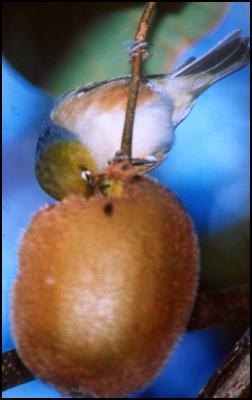Wild kiwifruit a serious threat to environment
MEDIA RELEASE
Wild kiwifruit a serious threat to
environment
For immediate release: Wednesday 8 June
2005

CAPTION: Bird snack on ripe kiwifruit and then spread the seeds.
Kiwifruit orchardists and farmers are being asked for their help in limiting the spread of wild kiwifruit in the Bay of Plenty.
Wild kiwifruit has been growing in the native bush gullies and small exotic forestry blocks of the Te Puke district since the 1970s. It has now established further afield, around Katikati, Opotiki and parts of the Rotorua district.
Environment Bay of Plenty pest plant coordinator John Mather says kiwifruit seeds are often spread by birds, and possibly rats and possums. “So it’s important to give them little opportunity to snack on ripening fruit,” he says.
Mr Mather asks farmers who feed reject fruit to stock to cover the piles with lengths of windbreak, a material that breathes and will not hasten fruit ripening. It’s best to feed out from the stockpile every day or two so large quantities are not left lying around, he says.
Kiwifruit orchardists can also help by removing reject fruit from vines and mulching it as soon as possible, before it ripens and birds get to it. Once fruit is dropped between rows and mulched by a mower it quickly breaks down into compost material.
Wild kiwifruit are serious environmental weeds. Vines pose a danger to native bush and exotic forest, as they are very long-lived and grow prolifically, strangling and even breaking trees. A single 30-year-old wild vine can smother 1000 square metres of scrub and young bush. Because of this, wild kiwifruit is included in Environment Bay of Plenty’s regional pest strategy as a total control plant. The regional council and the kiwifruit industry are also tackling the situation with an annual, jointly-funded control programme.
Though successful, Mr Mather says the problem may well be a long term one. “Unfortunately, the number of infestations has grown exponentially in the western Bay of Plenty. Many of the known sites are new ones, with vines less than four years old. This is probably resulting from recently distributed seeds from the thousands of tonnes of reject fruit.”
It is fortunate that most wild kiwifruit does not reproduce until it is five years old and it is thought that seeds have a relatively short life, possibly of less than five years, he adds. “These factors make it easier to control generally. However, if left to spread, this control would become increasing difficult and expensive.”
Environment Bay of Plenty has a fact sheet that describes the best ways to minimise the establishment and further spread of wild kiwifruit. Call into an Environment Bay of Plenty office for a copy, phone 0800 ENV BOP (368 267) or go to www.envbop.govt.nz. Click publications/pest plant fact sheets.
ENDS


 Gordon Campbell: On The Aussie Election Finale
Gordon Campbell: On The Aussie Election Finale UnionAID: Fiji Union Leader Visiting NZ Highlighting Struggle Of Garment Workers
UnionAID: Fiji Union Leader Visiting NZ Highlighting Struggle Of Garment Workers Hokotehi Moriori Trust: Historic Translocation Of Hakoakoa Marks New Chapter In Moriori Conservation Leadership
Hokotehi Moriori Trust: Historic Translocation Of Hakoakoa Marks New Chapter In Moriori Conservation Leadership Department Of Internal Affairs: Government Chief Digital Officer Issues Standard To Protect Government-Held Personal Information
Department Of Internal Affairs: Government Chief Digital Officer Issues Standard To Protect Government-Held Personal Information Te Pāti Māori: Keep The Window Open- UCOL Must Stay
Te Pāti Māori: Keep The Window Open- UCOL Must Stay Unions Otago: May Day Workers' Hui
Unions Otago: May Day Workers' Hui People Against Prisons Aotearoa: Voting Ban “Undermines Democratic Principles” Says Justice Group
People Against Prisons Aotearoa: Voting Ban “Undermines Democratic Principles” Says Justice Group


